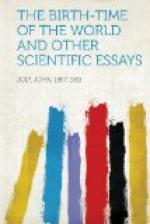Dravidian Era of India, 135.
E.
Earth, early history of, 3, 4; dimensions of, relative to surface features, 117.
Earth’s age determined by thickness of sediments, 5; determined by mass of the sediments, 7; determined by sodium in the ocean, 12; determined by radioactive transformations, 19; significance of, 2.
Earthquakes associated with geosynclincs, 142.
Efficiency, tendency to maximum, in organisms, 113, 114.
Elements, probable wide diffusion of rare, 230; rarity of radioactive, 241.
Elster and Geitel, photo-electric activity and absorption, 207; photo-electric properties of gelatin, 212; Emanation of radium, therapeutic use of, 256-259; advantages of, in medicine, 256; volume of, 257; how obtained, 257; use of, in needles, 258.
Equilibrium amount, meaning of, 254, 255.
Evolution and acceleration of activity, 79; of the universe not eternal a pane ante, 298.
F.
Faraday and ionisation, 57.
Finality of progress a part, post, 289.
Flahault, experiments on colour of flowers, 108.
Fletcher, A. L., proportionality of thorium and uranium, 26,
G.
Galileo, discovery of Jupiter’s moons, 162.
Gamma rays, nature of, 247: production of, by beta rays, 247; as ionising agents, 249.
Geddes and Thomson, hunger and living matter, 71.
Geiger, range of alpha rays in air, 215; ionisation affected by alpha rays in air, 216; on “scattering,” 217; scattering and the structure of the halo, 232.
Geikie, Sir A., uniformity in geological history, 15.
Geosynclines, 119; association with earthquakes and volcanoes, 142; of the tethys, 142; radioactive heat in, due to sediments, 130; temperature effects due to lateral compression of, 131.
Glacial epoch, phenomena of, 287.
Glacier motion, cause of. 285.
Glossopteris and Gangamopteris flora, 136.
Gondwanaland, 136.
Gradient of temperature in Earth’s surface crust, 126.
H.
Haimanta period of India, 135.
Halley, Edmund, finding age by saltness of ocean, 13.
Hallwachs, photo-electric activity and absorption, 207.
Haloes, pleochroic, finding age of rocks by, 21; due to uranium and thorium families, 227; radii of, 227; over-exposed and underexposed, 228; intimate structure of, 229 et seq.; artificial, 229; tubular, in mica, 230; extreme age of, 231; effect of nucleus on structure of, 232; inference from spherical form of, in crystals, 233; structure of, unaffected by cleavage, 235; origin of the name “pleochroic,"235; colouration due to iron, 235; colouration not due to helium, 236; age Of, 236; slow formation of, 237, 238; number of rays required to build, 237; and age of the Earth, 238-241.
Hayden, H.H., geology of the Himalaya, 134, 138, 139.




